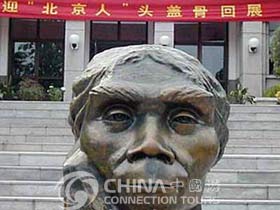
 Zhoukoudian, situated 50 kilometers to the southwest of Beijing proper, is the former residence of Peking man, who lived here approximately 200,000 to 500,000 years ago. In the 1920s archaeologists discovered a complete skull of an ape-man dating back 600,000 years which was later named as Peking Man. Stone tools and evidence of Peking Man's use of firs were later found on the mountain. Studies have shown that Peking Man walked on his feet and lived 690,000 years ago. His society lived in groups in caves and survived by hunting. The group could make use of rough stone tools and knew how to use fire for heating and cooking.
Zhoukoudian, situated 50 kilometers to the southwest of Beijing proper, is the former residence of Peking man, who lived here approximately 200,000 to 500,000 years ago. In the 1920s archaeologists discovered a complete skull of an ape-man dating back 600,000 years which was later named as Peking Man. Stone tools and evidence of Peking Man's use of firs were later found on the mountain. Studies have shown that Peking Man walked on his feet and lived 690,000 years ago. His society lived in groups in caves and survived by hunting. The group could make use of rough stone tools and knew how to use fire for heating and cooking.
At present, Zhoukoudian's Dragon Bone Hill has an exhibition hall, which is divided into seven rooms. The first room exhibits fossil remains of Peking man, stone tools, and evidence of Peking man's use of fire. These exhibits also depict Peking man's external appearance and general living conditions. The second room demonstrates Hilltop Caveman's fossils, stone tools, bone needles, decorative objects and animal fossils. The third room illustrates fossils of man discovered in various parts of China, such as Dingcun Man, Hetao Man, Ziyang Man, Zhalainuoer Man and other fossil copies of the ancient jungle ape, southern ancient ape, Java Man, Neanderthal Man and Cro-Magnon Man that provide an overall understanding of human evolutionary development. The fourth room introduces the geological history of Peking man's residence site and displays the process of human and animal evolution through different geological periods. The fifth and sixth rooms exhibit vertebrate fossils discovered in other locations around Zhoukoudian, including a display of fish fossils. The seventh room contains the fossils of some of the animals hunted by Peking man. Among them, the tiger and bear were considered Peking man's enemies. The discovery of elephant and rhinoceros fossils at the site demonstrates that the climate during the time of Peking man was far warmer than it is today.
In addition, one can see the actual caves in which Peking Man and Hilltop Caveman lived. The cave at Site No.1 originally measured 140 meters from east to west. Its  width was irregular and it had a height of more than 40 meters. The cave was first occupied approximately 500,000 years ago, and it is estimated that Peking Man maintained this residence over the course of a quarter of a million years. The bones of Peking Man discovered in the cave in the hill's north face include six complete or relatively complete skulls, eight skull fragments, six pieces of facial bone, 15 mandibles, 153 teeth, seven sections of broken femur, one broken shinbone, three pieces of upper arm bone, one clavicle and one wrist bone belonging to more than 40 individuals of different ages and sexes, although the materials are fragmentary of human fossil remains from this particular stage of human development.
width was irregular and it had a height of more than 40 meters. The cave was first occupied approximately 500,000 years ago, and it is estimated that Peking Man maintained this residence over the course of a quarter of a million years. The bones of Peking Man discovered in the cave in the hill's north face include six complete or relatively complete skulls, eight skull fragments, six pieces of facial bone, 15 mandibles, 153 teeth, seven sections of broken femur, one broken shinbone, three pieces of upper arm bone, one clavicle and one wrist bone belonging to more than 40 individuals of different ages and sexes, although the materials are fragmentary of human fossil remains from this particular stage of human development.
Until today, Peking Man holds as ever a realistic and scientific value. The Peking Man Site is representing the most comprehensively and systematically studied site of Homo erectus. The Peking Man Site also provides the more precise scientific data for the study of the evolution, behavior, and pale environment of Homo erectus than contemporary African and European sites.

